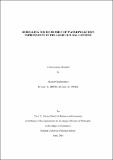| dc.description.abstract | This thesis consists of six separate yet connected chapters dealing with the impact on farm income of implementing the Water Framework Directive (WFD Directive 2000/60/EC). The first chapter is an introduction to the research conducted in this thesis. The second chapter is a review of the literature on water quality and water pollution in general and on the water quality as intended in the WFD. The review in chapter two is undertaken to provide a comprehensive understanding of water quality and water pollution, the current policy challenges and the gaps in the existing research that must be addressed.
The third chapter of the thesis is an econometric analysis of the key drivers of water quality in Irish river systems. The analysis is undertaken by combining data from the Environmental Protection Agency Ireland (EPAI) water quality monitoring stations with spatially referenced information on the river catchments, information from the Irish census of agriculture, septic tank density data, population density and environmental data in a Geographical Information System (GIS) framework. The main factors associated with water quality in Irish rivers are assessed using an ordered probit model. The aim of this analysis is to establish the contributing sources that are associated with the lower water quality in Irish rivers.
The fourth chapter introduces a simulation model with some extensions and sensitivity analysis. This model is developed with a view to provide decision-makers with information about the impacts of environmental policies on farm's operations and income. In particular, the policies that affect farms' nitrogen (N) balance are considered. The model aids the economic assessment of the effect of N mitigation measures in Ireland. Within the microsimulation framework, econometric estimations are employed to simulate the changes in farm income and farm N balance that would arise from N pollution reduction measures on dairy farms in Ireland. As a case study, the two mitigation measures that have previously been assessed by Hennessy et al. (2005) and Fezzi et al. (2008) are considered, namely: 1) a stocking rate reduction to achieve a maximum organic nitrogen of 170 kg/ha; 2) a 20 percent stocking rate reduction. Then, as a model extension, the cost-effectiveness of seven farm level N mitigation measures is compared through calculating the Cost per Unit Abated (CPUA) displaying the cost of each N unit reduction for each measure and ranking the abatement measure by CPUAs. This chapter also attempts to fill the gap in the existing research literature and provide stakeholders with economic analysis informing the decision-making process concerning policies for the agricultural sector. The country average CPUA for each measure as well as CPUA ranking for individual farms are reported and discussed. Furthermore, the sensitivity analysis of the CPUA results and their ranking to price changes is conducted. Usually the price volatility analysis is related to the potential negative effects on consumer welfare especially in poorer households from rising food prices. In chapter VI the effect of price volatility on CPUA is explored instead. In particular, this study highlights that the assessment and in turn the ranking of mitigation measures will depend on the commodity and input prices prevailing in the particular period when the analysis is conducted.
The fifth chapter is a case study that is conducted using a spatial microsimulation model. In this chapter, the costs associated with protecting an endangered species - namely the freshwater pearl mussels (FWPM) Margaritifera Margaritifera and Margaritifera Duravensis are calculated in the relevant river catchments. The importance of this analysis is threefold. First, the use of the spatial microsimulation model in order to assess the policy impact at a relevant spatial level. Second, the requirement to protect the FWPM protected under the Habitats Directive (Council Directive 92/43/EEC), the Wildlife Acts ((Wildlife Act No 39 of 1976), amended 2000) and the Water Framework Directive (Directive 2000/60/EC). Finally, the falling numbers of these pearl mussels suggest a decline in water quality. The declining numbers of once abundant fresh water pearl mussels is one of the indicators of deteriorating water quality highlighting the need for a habitat protection policy in Ireland. This mollusc is not only a very sensitive organism that signals the water pollution problem but it is a unique and endangered species that has to be preserved for future generations. However, protecting the endanger species is a costly business, which is highlighted in this chapter.
The overall conclusions and discussion of the research undertaken in this thesis and the research findings are given in chapter six and this concludes the thesis. | en_US |


